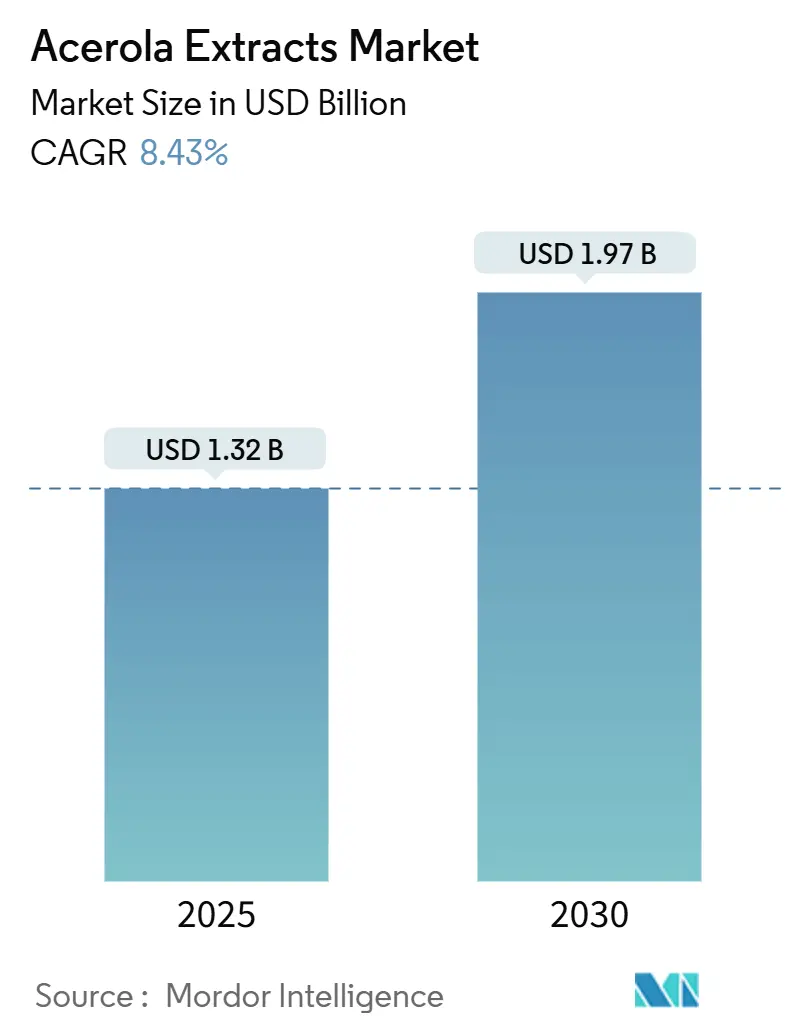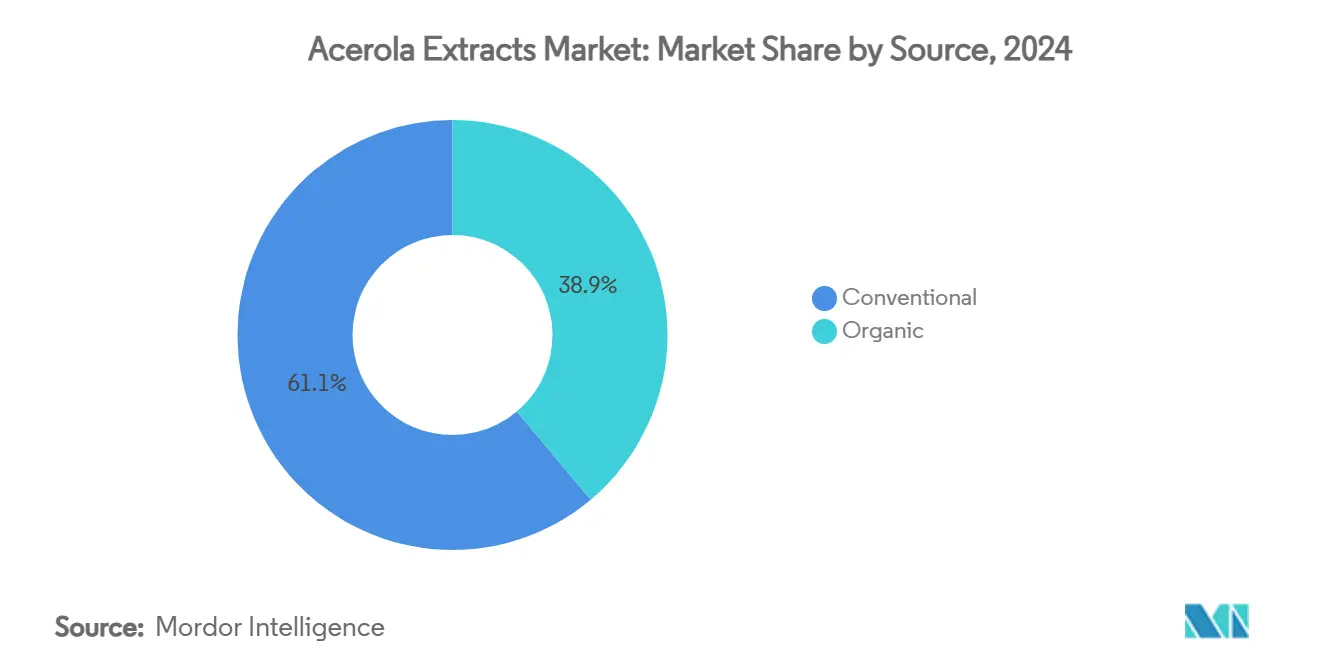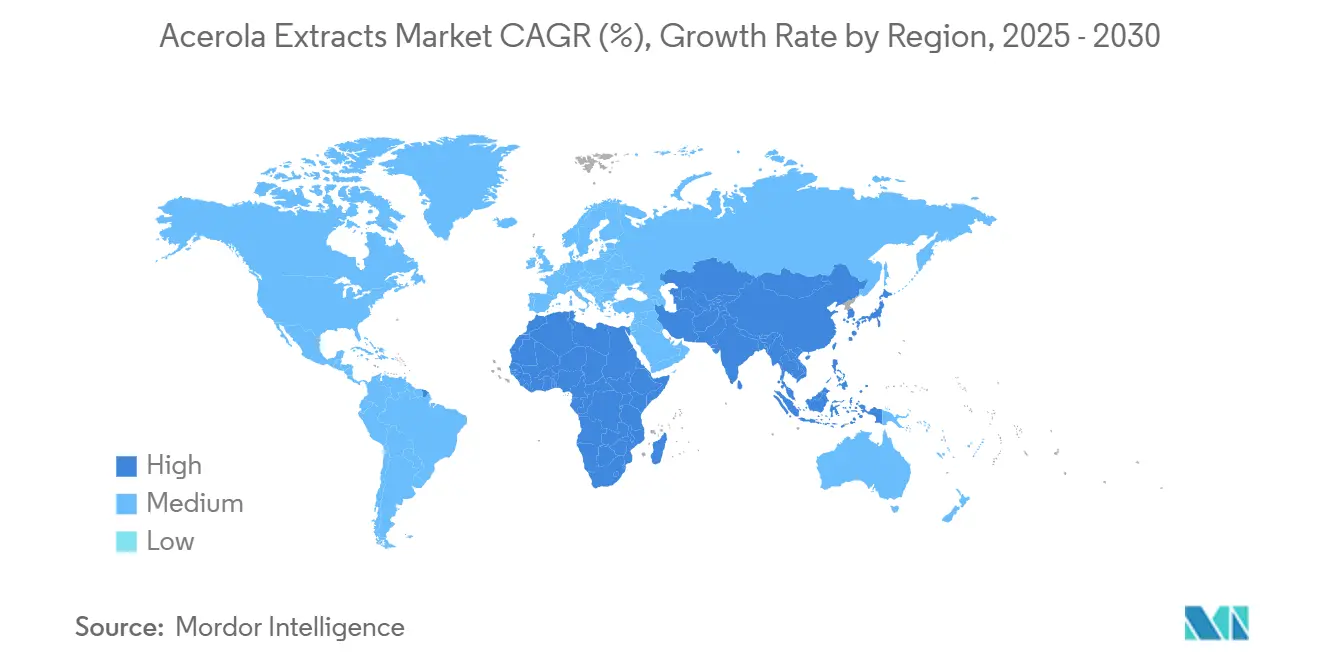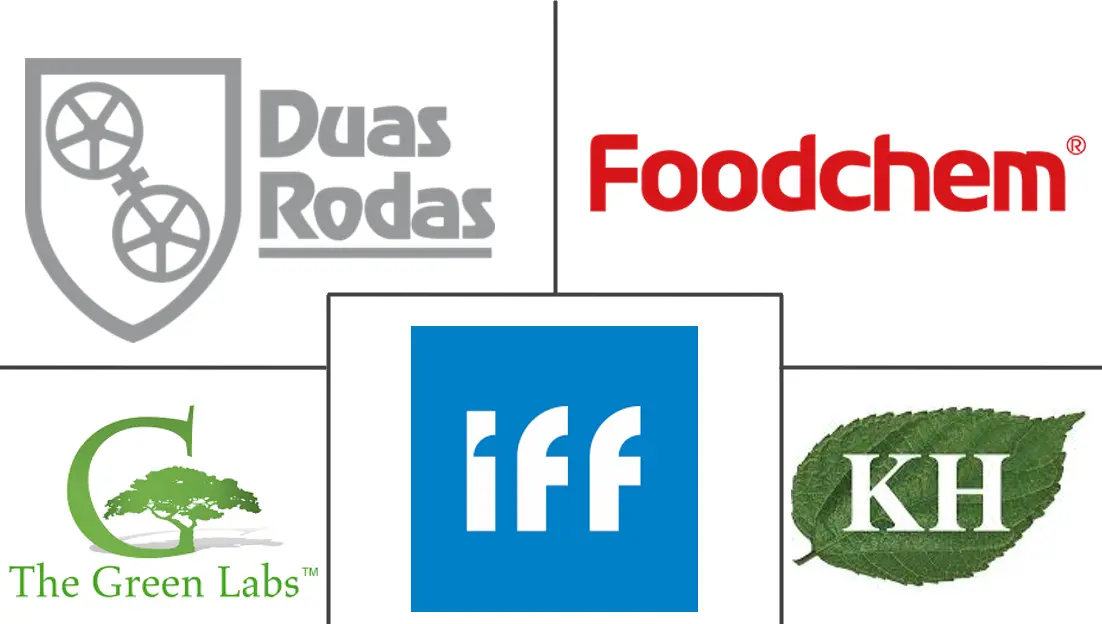Acerola Extracts Market Size and Share

Acerola Extracts Market Analysis by Mordor Intelligence
The acerola extracts market is estimated to be valued at USD 1.32 billion in 2025 and is projected to reach USD 1.97 billion by 2030, expanding at a CAGR of 8.43%. The market growth is driven by increased consumer focus on immune health, adoption of natural preservatives in food and beverage manufacturing, and demand for clean-label ingredients in supplements, food, and beauty products. The consistent demand for vitamin C-rich formulations and growing regulatory acceptance of fruit-based antioxidants support frequent product launches with distinct offerings. Companies that integrate farming, extraction, and application development capabilities maintain advantages in securing raw materials, ensuring quality standards, and establishing a presence in high-margin market segments.
Key Report Takeaways
- By source, the conventional segment led with 61.12% of acerola extract market share in 2024, while the organic segment is projected to expand at a 12.51% CAGR to 2030.
- By form, powder commanded a 65.95% share of the acerola extract market in 2024; liquid forms are advancing at a 10.16% CAGR through 2030.
- By application, dietary supplements accounted for 58.96% of the acerola extract market in 2024 and are rising at an 11.64% CAGR between 2025-2030.
- By geography, North America held 36.49% revenue share of the acerola extract market in 2024, whereas Asia-Pacific is forecast to register the fastest 10.87% CAGR to 2030.
Global Acerola Extracts Market Trends and Insights
Driver Impact Analysis
| Driver | (~) % Impact on CAGR Forecast | Geographic Relevance | Impact Timeline |
|---|---|---|---|
| Increasing demand for natural preservative | +2.1% | Global, with stronger impact in North America and Europe | Medium term (2-4 years) |
| Rising prevalence of vitamin c deficiency | +1.4% | Global, with significant impact in Asia-Pacific and Africa | Long term (≥ 4 years) |
| Growing awareness of immune health benefits among consumers | +1.8% | Global, with stronger impact in North America and Europe | Short term (≤ 2 years) |
| Rising demand for natural and clean-label ingredients | +1.6% | Global, with stronger impact in North America and Europe | Medium term (2-4 years) |
| Beauty and personal-care premiumisation around acerola actives | +0.9% | Global, with stronger impact in Asia-Pacific and Europe | Medium term (2-4 years) |
| Growing use of acerola extract as a natural antioxidant and colorant in foods | +0.7% | Global, with stronger impact in North America and Europe | Medium term (2-4 years) |
| Source: Mordor Intelligence | |||
Increasing Demand for Natural Preservative
The increasing consumer demand for clean-label products drives the adoption of acerola extract as a natural preservative in the food industry. The high vitamin C content in acerola prevents oxidation and extends product shelf life without synthetic additives. Food manufacturers incorporate acerola extract for both its preservation capabilities and nutritional benefits, enabling them to develop products with longer shelf life and improved nutritional value. This combination allows companies to position their products in premium market segments and set higher prices while meeting consumer preferences for clean-label alternatives. According to the International Journal of Scientific Research and Technology in 2025, natural preservatives enhance food safety and represent a growing trend in the food industry, reducing dependence on synthetic additives [1]International Journal of Scientific Research and Technology, “Latest Advances in Food and Cosmetics Preservatives: Safety and Legality,” ijsrtjournal.com. The use of natural preservatives meets consumer demand for clean-label products, which consumers consider healthier and more environmentally sustainable. Additionally, these preservatives help extend food product shelf life, minimize food waste, and improve food safety.
Rising Prevalence of Vitamin C Deficiency
Vitamin C deficiency remains a significant global health concern, according to several research studies published in clinical journals. In response to this widespread issue, pharmaceutical and nutraceutical companies have developed advanced vitamin C formulations with enhanced bioavailability. Acerola extract has emerged as a natural alternative to synthetic ascorbic acid, containing essential bioflavonoids and co-factors that significantly improve vitamin C absorption and utilization in the body. The market for acerola-based products has experienced substantial growth as healthcare providers increasingly recommend food-based vitamin C sources over isolated supplements. This shift in preference has demonstrated promising results in improving clinical outcomes for patients with nutritional deficiencies, especially in vulnerable populations requiring sustained vitamin C supplementation.
Growing Awareness of Immune Health Benefits Among Consumers
Acerola extract contains natural vitamin C concentrations up to 100 times higher than citrus fruits, making it a significant ingredient for immune support in the nutraceutical market. Manufacturers are developing formulations that combine acerola with elderberry, zinc, and echinacea to create comprehensive immune support products. The market demonstrates increased demand for daily preventative supplements, as consumers adopt regular supplementation with natural, food-based ingredients. This trend reflects consumer awareness about maintaining immune health through natural, scientifically-validated ingredients, particularly in response to global health concerns. In June 2025, Amway India expanded its immunity portfolio by launching Nutrilite Triple Protect, a plant-based blend of Acerola Cherry, Turmeric, and Licorice that supports immunity, skin health, and gut balance.
Rising Demand for Natural and Clean-Label Ingredients
Acerola extract has emerged as a fundamental ingredient in the clean-label movement, which has evolved from a market trend to an established industry standard. Market research indicates that natural preservatives, particularly acerola, are progressively replacing synthetic alternatives such as potassium sorbate and sodium benzoate across the food and beverage industry. In supplement manufacturing, companies utilize acerola powder for its dual functionality - as a natural preservative and a significant source of nutrients, especially vitamin C. The applications of acerola extract have expanded into natural food coloring, with manufacturers implementing environmentally sustainable green extraction methods to maximize its potential. This versatile combination of preservation capabilities, nutritional enrichment, and natural coloring properties has accelerated acerola extract adoption across multiple product categories, including beverages, baked goods, confectionery, and dietary supplements, providing significant advantages to companies committed to clean-label formulations.
Restraints Impact Analysis
| Restraint | (~) % Impact on CAGR Forecast | Geographic Relevance | Impact Timeline |
|---|---|---|---|
| Climate-driven supply volatility in Brazil and Caribbean belt | -1.2% | Global, with direct impact on Brazil and Caribbean countries | Long term (≥ 4 years) |
| High production costs | -0.9% | Global, with stronger impact in emerging markets | Medium term (2-4 years) |
| Limited shelf life of acerola extract products | -0.6% | Global | Short term (≤ 2 years) |
| Availability of the alternatives | -0.8% | Global | Medium term (2-4 years) |
| Source: Mordor Intelligence | |||
Climate-driven supply volatility in Brazil and Caribbean belt
Climate change poses significant challenges for acerola cultivation in major growing regions, affecting global supply chain stability. Research from the I International Congress on Climate Change and its Consequences in Semi-Arid Territories demonstrates the link between climate conditions, pollinator behavior, and acerola productivity [2]Universidade Federal do Vale do São Francisco, “Brazilian Solar Energy Potentiality,” portais.univasf.edu.br. The study shows that Centris caxiensis bees, which are crucial for acerola pollination, display high sensitivity to climate variations, impacting their populations and behavior. The concentration of production in specific regions, particularly Brazil as the primary producer, increases the risk of supply chain disruptions. Companies are addressing these challenges by expanding cultivation to new regions, implementing climate-resilient farming methods, and developing stable extract formulations. However, these adaptations increase operational costs and complexity, affecting the market's growth potential.
High Production Costs
Preserving the bioactive compounds of acerola involves a multi-stage extraction process. This begins with the careful harvesting of ripe fruit, followed by thorough washing, precision crushing, advanced solvent extraction, and purification through specialized centrifugation and chromatography. Such an intricate process requires a significant capital investment in cutting-edge equipment and a team of highly skilled technicians. To ensure consistent potency and purity, rigorous quality control measures, including detailed spectrophotometric analysis and comprehensive HPLC testing, are implemented, further driving up production costs. Producing organic acerola extract introduces added challenges, given the stringent certification requirements, intensive documentation, and typically lower yields, all of which justify a premium pricing structure. While larger manufacturers can leverage economies of scale to offset some of these costs, smaller producers grapple with challenges in maintaining competitive pricing. This cost-intensive landscape predominantly favors established manufacturers, erecting substantial barriers for newcomers and potentially stifling the introduction of innovative extraction methods or novel application technologies.
Segment Analysis
By Source: Organic Segment Accelerates Premium Growth
Conventional acerola extract holds 61.12% of the market share in 2024, driven by competitive pricing and widespread availability. The organic segment is projected to grow at a CAGR of 12.51% through 2030, as consumers demonstrate willingness to pay premium prices for pesticide-free vitamin C sources. Companies are establishing traceable supply partnerships with Brazilian smallholder farmers who implement regenerative agriculture practices, which helps secure raw material supply and supports sustainability initiatives.
North America and Europe show the highest demand for organic acerola extract, influenced by certification requirements, carbon-footprint labeling, and retail standards. While conventional extract maintains its position in mass-market beverages, ambient bakery products, and price-sensitive emerging markets, the market value growth is expected to shift toward organic products through 2030.

By Form: Powder Dominates While Liquid Gains Momentum
Powder forms accounted for 65.95% of the acerola extract market size in 2024, attributed to their superior stability, simplified storage requirements, and precise dosing capabilities. Meat processors utilize high-titer powders (30-40% vitamin C) as alternatives to synthetic ascorbic acid, which effectively reduces nitrite levels and minimizes nitrosamine formation. The powder format also enables manufacturers to maintain consistent product quality, extend shelf life, and ensure accurate ingredient incorporation across various applications.
Liquid extracts are expected to grow at a CAGR of 10.16% during 2025-2030, driven by increased demand in ready-to-drink beverages, cosmetic serums, and concentrated drops. Improvements in microencapsulation and fermentation technologies enhance shelf life and skin-delivery efficacy, creating opportunities in dermocosmetics where texture and dispersibility influence consumer choices. The liquid format offers advantages in rapid absorption, uniform blending in beverage applications, and enhanced bioavailability, making it particularly suitable for functional drinks and skincare formulations.
By Application: Dietary Supplements Lead Multi-Sector Growth
The dietary supplements segment accounted for 58.96% market share in 2024 and is projected to grow at a CAGR of 11.64% through 2030. Extensive clinical research demonstrating the direct relationship between vitamin C consumption and enhanced immune and metabolic health continues to drive robust consumer demand for fruit-derived active ingredients. Manufacturers are developing innovative product formats, including chewables, gummies, and effervescent tablets that strategically combine acerola with elderberry or zinc for comprehensive immune system support and optimal health outcomes.
The food and beverage industry extensively utilizes acerola extract as both a natural preservative and nutrient fortifier, while the cosmetics sector incorporates its potent antioxidant properties in formulations targeting oxidative stress and hyperpigmentation concerns. The pharmaceutical segment, despite its currently smaller market share, demonstrates increasing research interest in combining acerola with plant polyphenols for supplementary treatment protocols in chronic disease management, indicating significant potential for expanding high-value therapeutic applications.

Note: Segment shares of all individual segments available upon report purchase
Geography Analysis
North America held a 36.49% share of the acerola extract market revenue in 2024. The United States represents the largest market in the region, with supplement manufacturers prioritizing acerola's natural phytonutrient profile over synthetic vitamin C alternatives. Health Canada's 2025 antioxidant monograph provides regulatory clarity for acerola in supplement formulations, establishing dosage requirements and permissible health claims, which supports product development in the Canadian market.[3]Kemin Industries, “FORTIUM A Product Overview,” Kemin, kemin.com
The Asia-Pacific market is expected to grow at a CAGR of 10.87% through 2030. China is expanding the use of acerola in functional beverages, while Japan is developing acerola-based nutricosmetics and facial masks for department store distribution. In India, manufacturers are combining acerola with amla in ayurvedic formulations to align with traditional preferences. Regional marketing focused on immunity and skin benefits is driving consumer demand, leading to direct sourcing partnerships between Brazilian processors and Asian manufacturers.
Europe holds a significant market share, with Germany and France showing the highest adoption of organic extracts. Strict regulations on additives and consumer confidence in certification drive acerola's use as a natural antioxidant and color stabilizer in bakery fillings, premium dairy products, and baby food. While South America continues to be the primary cultivation region, Brazil's domestic consumption increases with growing middle-class health expenditure. The Middle East and Africa show lower overall volumes but demonstrate premium product adoption in specific segments, particularly fortified juices distributed through pharmacies.

Competitive Landscape
The acerola extract market exhibits moderate fragmentation. Major companies like Givaudan, DSM-Firmenich, and Kemin operate integrated seed-to-solution models, managing the entire value chain from cultivation and extraction to application research. This integration enables quality control in fruit production, minimizes pesticide residue risks, and reduces product development cycles, helping companies access high-margin market segments.
Specialized manufacturers such as Duas Rodas and Premier Naturals focus on proprietary technology development. These companies invest significantly in research and development to create unique product formulations that address specific market needs. Their emphasis on innovation and specialized solutions allows them to maintain competitive positions in the market.
Duas Rodas offers Vitamin-Ace, which provides standardized 40% natural ascorbic acid content for food preservation and immune health applications. Premier Naturals manufactures fermented acerola extracts with anti-glycation properties for premium skincare products. These specialized formulations command premium prices and create market entry barriers through intellectual property protection.
Acerola Extracts Industry Leaders
-
International Flavors and Fragrances Inc.
-
Kingherbs Limited
-
Foodchem International Corporation
-
Duas Rodas
-
The Green Labs LLC
- *Disclaimer: Major Players sorted in no particular order



Recent Industry Developments
- March 2025: Premier Naturals, the natural cosmetics division of OnScent, introduced its Acerola Cherry Ferment. The product meets high sustainability standards through ISO 16128 certification, vegan formulation, and environmental sustainability practices.
- November 2022: Duas Rodas introduced Vitamin-Ace 40, an acerola extract containing 40% standardized natural vitamin C. The company developed this product specifically for the food supplement industry.
Global Acerola Extracts Market Report Scope
Acerola extract can be described as a source of Vitamin C extracted from the acerola cherry plant and the fruit is considered an exotic variety that has exceptional agro-industrial potential and represents an alluring economic prospect. The global acerola extract market (henceforth referred to as the market studied) is segmented by product form, application, and geography. By product form, the market is segmented into liquid and powder. On the basis of application, the market is segmented into food and beverage, pharmaceuticals and healthcare, beauty and personal care, and animal feed. The study provides an analysis of emerging and established economies across the world, comprising North America, Europe, South America, Asia-Pacific, and the Middle-East & Africa. For each segment, the market sizing and forecasts have been done on the basis of value (in USD million).
| Conventional |
| Organic |
| Liquid |
| Powder |
| Dietary supplements |
| Food and Beverage |
| Pharmaceuticals |
| Cosmetics and Personal Care |
| Others |
| North America | United States |
| Canada | |
| Mexico | |
| Rest of North America | |
| Europe | Germany |
| France | |
| United Kingdom | |
| Spain | |
| Netherlands | |
| Italy | |
| Sweden | |
| Poland | |
| Belgium | |
| Rest of Europe | |
| Asia-Pacific | China |
| India | |
| Japan | |
| Australia | |
| Rest of Asia-Pacific | |
| South America | Brazil |
| Argentina | |
| Rest of South America | |
| Middle East and Africa | United Arab Emirates |
| South Africa | |
| Saudi Arabia | |
| Rest of Middle East and Africa |
| By Source | Conventional | |
| Organic | ||
| By Form | Liquid | |
| Powder | ||
| By Application | Dietary supplements | |
| Food and Beverage | ||
| Pharmaceuticals | ||
| Cosmetics and Personal Care | ||
| Others | ||
| By Geography | North America | United States |
| Canada | ||
| Mexico | ||
| Rest of North America | ||
| Europe | Germany | |
| France | ||
| United Kingdom | ||
| Spain | ||
| Netherlands | ||
| Italy | ||
| Sweden | ||
| Poland | ||
| Belgium | ||
| Rest of Europe | ||
| Asia-Pacific | China | |
| India | ||
| Japan | ||
| Australia | ||
| Rest of Asia-Pacific | ||
| South America | Brazil | |
| Argentina | ||
| Rest of South America | ||
| Middle East and Africa | United Arab Emirates | |
| South Africa | ||
| Saudi Arabia | ||
| Rest of Middle East and Africa | ||


Key Questions Answered in the Report
What is the current value of the acerola extract market?
The acerola extract market is valued at USD 1.32 billion in 2025.
Which region is growing fastest for acerola extract demand?
Asia-Pacific is projected to expand at a 10.87% CAGR between 2025-2030, the highest regional growth rate.
Why is the organic acerola segment expanding more rapidly than conventional?
Certified organic extract meets consumer priorities for pesticide-free, traceable ingredients and is forecast to grow at 12.51% CAGR through 2030.
How does acerola extract function as a natural preservative?
Its high vitamin C and antioxidant content delays oxidation, stabilizes color, and extends shelf life in meat, beverage, and bakery products.
Page last updated on:








